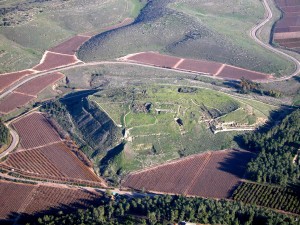Driving for about half an hour south-southwest from Tel Beth-Shemesh, where we were in the last issue of BiBloS, we arrive at another mound – one of the largest and most prominent in southern Israel. This is Tel Lachish, the site of a major fortified city of ancient Judah and of an historic defeat during the late eighth century B.C. Second only in importance to Jerusalem, Lachish is situated just 25 miles southwest of the capital.
In the 1930s British archaeologists discovered a Late Bronze Age temple, now known as the Fosse Temple as it was discovered in the ditch at the foot of the mound. Artefacts from this can be found today in the British Museum. This might well have been in use at the time of the conquest of the land under Joshua, following the days of Moses.
“Then Joshua and all Israel with him passed on from Libnah to Lachish and laid siege to it and fought against it. And the LORD gave Lachish into the hand of Israel …” (Joshua 10:31-32) where it was allocated to the tribe of Judah. Following the division of the kingdom, Rehoboam fortified the city which then became one of several principal defensive cities guarding the valleys that lead up to Jerusalem from the coastal regions.
In 701 B.C., some 20 years following the defeat of the northern kingdom of Israel, Sennacherib, king of Assyria, invaded Judah and destroyed many of its fortified cities. The last of these to fall was the city of Lachish. Although Jerusalem was next on Sennacherib’s hit list, the Assyrians were unable to take the capital city as God would not allow it to be destroyed – at least not yet.
When Sennacherib returned to Nineveh, he had made a series of wall panels depicting the siege of Lachish which are now on display in the British Museum. They clearly show the city under attack “by means of well-stamped earth-ramps, and battering-rams brought thus near to the walls combined with the attack by foot soldiers …” as described in an Assyrian document from the same period, also housed in the Museum.
Visiting the site of the city today we can clearly see one of these siege ramps in place from over 2,500 years ago. It is the only surviving Assyrian siege ramp known to exist. Also still evident today is the gatehouse where a number of Hebrew letters were discovered written on pieces of pottery, or ostraca. These date from the period following the Assyrian destruction, immediately prior to the Babylonian invasion by Nebuchadnezzar.
Patrick Boyns
 This article is from BiBloS, a teaching resource of the British Bible School. To read more articles or download the whole of Issue 2, click here.
This article is from BiBloS, a teaching resource of the British Bible School. To read more articles or download the whole of Issue 2, click here.


